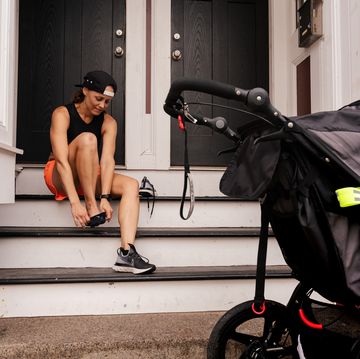Back in November, pro middle-distance runner Alysia Montaño underwent surgery to treat her diastasis recti—a partial or complete separation of the rectus abdominis (a.k.a. abdominal muscles), which meet at the midline of your stomach.
Montaño, an 800-meter runner who came in 5th in the 2012 Olympics, is a seven-time national champion and a two-time world champion, has been documenting her recovery journey on her Instagram.
To help other runners going through the same condition as Montaño, we spoke with two experts to find out what diastasis recti is, why it happens in the first place, how it can impact the quality of your postpartum running life, and what are the ways to treat and prevent it.
What Is Diastasis Recti?
Diastasis recti occurs when the linea alba—the band of tissue that connects your left and right rectus abdominis (your “six-pack” muscles)—stretches, widening the space between the two muscle groups. In pregnancy, this commonly occurs because of pressure from the growing baby—in fact, almost all women have some degree of diastasis in the third trimester, says Sarah Haag, D.P.T., a Chicago-based physical therapist who specializes in pelvic-floor dysfunction and women’s health.
The result is a bulging of the abdomen, according to Kate VanDamme, P.T., D.P.T., O.C.S., a clinical specialist at NYU Langone Orthopedic Center.
In some cases, the linea alba naturally regains tension after pregnancy, and the gap separating the two rectus muscles closes on its own. But it isn’t uncommon that it doesn’t. Concern arises when this separation measures more than two finger widths, and a woman is unable to generate tension in her core to bring the two halves together, Haag said.
“When you have diastasis recti, you’re not fully supported in your middle, so your core is not able to function as effectively as it should,” she explains. In running, this may translate to symptoms such as hip or low back pain, leaking urine, or a decline in performance. “If you have a diastasis, you may notice deficits in your running until you are able to generate tension through your core again,” Haag adds.
Join Runner’s World+ today to become a stronger, healthier runner!
Why Does Diastasis Recti Occur?
There is a lot we still don’t know about why some women are affected by diastasis recti and others are not. And unfortunately, there is no surefire way to prevent having a significant gap or ensuring that the gap will close naturally postpartum, Haag says.
However, we do know some things that can help guide women on how they take care of their bodies during pregnancy and after.
Diastasis recti has two main causes: One is an increase in pressure against the intra-abdominal wall. While much of this is due to the baby pressing up against a woman’s belly, other forces can contribute to this pressure as well, including holding your breath during exercise and gripping your abs (holding your stomach tight), Haag says. When you do any of these things, your deep core muscles (pelvic floor, transverse abdominis, and diaphragm) can’t work effectively as a system and pressure increases.
Another is the stretching, loosening, and lengthening of the linea alba between the left and right side of the rectus abdominis muscle, which occurs in pregnancy to accommodate a growing fetus, VanDamme says. (She also notes that this can occur in a man or woman with significant weight gain or loss.)
How to Check for Diastasis Recti
It’s important for new moms to know if they have diastasis recti before returning to running or starting any workout routine. Many physicians and midwives don’t check for diastasis at a six-week postpartum visit, but you can perform a self-test to determine if you have it, according to Haag and VanDamme.
- Lie down on your back with knees bent at 90 degrees and feet flat on the floor. Place one finger (pointing downward) just below your ribcage.
- Exhale and engage your pelvic floor (imagine you’re stopping the flow of urine), then lift your head and shoulders a few inches off the ground.
- From this position, feel for the muscles on each side of your finger. You may feel that there is hardly any space at all, or there may be room to fit, two, three or more fingers between them. Note the distance (measured in finger-widths) between the muscles, as well as how deep you can put your fingers in the gap.
- Lie your head down and rest.
- Then repeat the test again, this time checking the area just above the navel. Continue checking for separation all the way down to your pubic bone.
If at any point, you feel a separation of more than two finger widths, this is considered a diastasis. The larger the gap and the deeper and more squishy the tissue between your abs, the more work you will need to do to restore function.
How to Treat Diastasis Recti
Diastasis recti does not require immediate medical attention and often resolves with no treatment at all, according to VanDamme, as it is not usually uncomfortable in and of itself.
“If you have diastasis recti, especially if this occurs as a result of pregnancy, you should watch for a slow and natural recovery in the separation as your body heals from the work of growing and birthing a human,” VanDamme says. “A large percentage of diastasis recti resolves naturally by six months postpartum in roughly 60 percent of first-time mothers.”
However, if you do have a gap, it’s never a bad idea to see a women’s health or pelvic-floor physical therapist who can give you specific exercises to help with the healing process, Haag says.
“A good physical therapist will break down the activity that you hope to do and integrate the components of the activity with the cause for concern,” Haag says.
For patients hoping to return to running, Haag often starts by having them learn to breathe properly and generate tension through their core while on hands and knees, then she incorporates movement of the extremities (such as in the bird-dog exercise), then she progresses to single-leg balance work. All of the exercises focus on finding the optimal position for their core to function with the pelvic floor and breathing, but this will vary from person to person.
Additionally, VanDamme likes to recommend the following transverse abdominal exercise:
- Lay on your back with your knees bent and your hands on your abdominal wall.
- Exhale slowly, as if you are blowing out a bunch of birthday candles (feel that this activates your transverse abdominis—the deepest muscle of the abdominals).
- Attempt to activate the transverse abdominis for many repetitions—eventually see if you can activate the muscle without using the forceful exhalation as you would with birthday candles.
“Treating diastasis recti is not about bracing the abs, it’s about helping a patient learn how to create tension and move the way they want to move,” Haag says.
You’ll also want to avoid any core work that causes your belly to “pooch” out, such as crunches, sit-ups, or twisting motions, and avoid repeatedly stretching the midline of your stomach tissue—so no upward dogs or wheel poses in yoga either, according to VanDamme.
You may also practice diaphragmatic breathing, VanDamme says, which is demonstrated below.
“What you want to feel while doing ab work is that your stomach flattens out,” Haag says.
Before returning to running, Haag recommends first walking to see if you experience any leaking, heaviness in your pelvis, or low back or hip pain. If you don’t experience any issues with walking, then you can feel more confident returning to running, she says. Depending on your activity levels before and during pregnancy, you can gradually increase your distance and speed.
“Please remember that as you progress, if you develop any pain or urinary leakage, talk to your physician and ask for a referral to physical therapy to make sure you’re doing all you can do to get back into the routine you love.”
With all that said, some women like Montaño require surgery to fix the issue.
“Opinions regarding the necessity of surgery vary widely and are extremely unique to each patient based on their cause of diastasis recti, the impact diastasis recti is having on their function, and their personal goals,” VanDamme says.
Prior to considering an invasive procedure like surgery, though, VanDamme advises exhausting all conservative interventions—such as exercise, stretching, and allowing time to heal—first.
Above all, Haag says, it’s important to know that if you have diastasis recti, it’s not your fault. “Have trust in your body. It’s going to heal, and there are people who can help.”


















